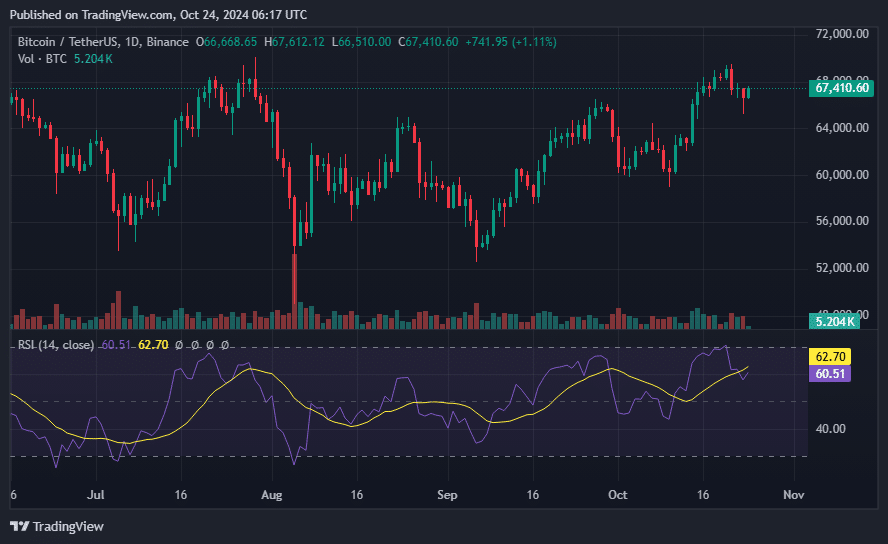On Oct. 23, investors in BlackRock’s IBIT capitalized on Bitcoin’s over 3% decline, contributing $317 million in inflows to the fund as the cryptocurrency tested a critical support level at $65,000.
On Oct. 23, Bitcoin faced significant downward pressure, sliding 3.3% to close at $66,649, a sharp contrast to the 0.12% gain in the previous session. Testing buyer demand at $65,000, BTC managed to find support with a session low of $65,161 before climbing back above the $66,000 level.
The broader cryptocurrency market mirrored this decline, shedding 1.45% to a total market capitalization of $2.242 trillion.
This decline can be attributed to shifting sentiment driven by concerns over the upcoming US Presidential Election and the Federal Reserve’s rate trajectory.
Risk assets, including Bitcoin, experienced selling pressure as investors grew wary of tightening monetary policy. The Nasdaq Composite Index fell by 1.60% as 10-year US Treasury yields surged to 4.26%, the highest since July, signaling strength in the US economy and challenging expectations for multiple Fed rate cuts in Q4 2024.
US presidential election and market impact
As the US Presidential Election approaches, uncertainty is adding further strain on investor sentiment. Recent polls indicate Vice President Kamala Harris leading former President Donald Trump by a narrow 1.7-point margin, though Trump has closed the gap significantly from a previous 3.7-point deficit.
Despite Harris’ lead, betting platform Polymarket gives Trump a higher chance of victory, with a 59.7% probability compared to Harris’ 40.4%.
A Trump presidency is expected to bring inflationary pressures, potentially leading to a more hawkish Federal Reserve stance. While this may dampen demand for riskier assets, including Bitcoin, Trump’s crypto-friendly policies could bolster longer-term demand for the digital asset.
Spot Bitcoin ETFs drive recovery
Despite the macroeconomic uncertainties, Bitcoin rebounded from the $65,000 support level, driven by renewed inflows into spot Bitcoin ETFs, particularly BlackRock’s IBIT. This came after a previous day of outflows, which saw $79.1 million exit the fund due to investor concerns that Bitcoin’s rally might be losing momentum.
On Oct. 23, the 12 spot Bitcoin ETFs recorded net inflows of $192.31 million, with BlackRock’s IBIT contributing the lion’s share of $317.47 million. This marked the fourth time in six trading days that the fund attracted over $300 million in inflows, bringing its total net inflows to over $23 billion as of Oct. 21.
Grayscale’s Bitcoin Minit Trust also contributed to the positive sentiment, recording $4.71 million in inflows, while other ETF products, including ARKB, BITB, and VanEck, saw collective outflows of $129.8 million, reflecting a more cautious stance from some market participants.
Technical outlook for Bitcoin
Despite Wednesday’s price dip, Bitcoin remains above key technical levels, including the 50-day and 200-day exponential moving averages, reinforcing bullish signals.

A potential breakout above the $69,000 resistance level and the Oct. 21 high of $69,402, could pave the way for a move toward the psychological $70,000 mark. Should Bitcoin successfully breach $70,000, bulls may attempt to challenge the all-time high of $73,808.
However, a drop below $66,500 could reignite bearish momentum, bringing the critical $65,000 support level back into focus. A further decline below $65,000 may open the door for a deeper correction, with $64,000 as the next key support.

With a 14-day Relative Strength Index reading of 60, Bitcoin has the potential to reach $70,000 before approaching overbought conditions.
At press time Bitcoin (BTC) was up 0.5%, exchanging hands at $67,345.
This article first appeared at crypto.news

